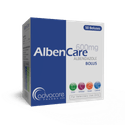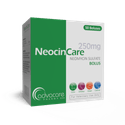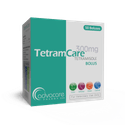- Home›
- Veterinary Pharmaceuticals›
- Veterinary Boluses›
- Sulfadimidine Boluses
Sulfadimidine Boluses
Dosage
Packaging
What is Sulfadimidine?
Active Ingredients: Sulfadimidine
Sulfadimidine Boluses is an antibiotic drug used to treat and prevent infections caused by bacteria, protozoa, and certain rickettsial organisms in camels, cows, goats, and sheep. It is effective for gastrointestinal infections and respiratory infections. This antibiotic also shows activity against certain protozoa, such as Eimeria and Isospora.
Sulfadimidine is classified as a sulfonamide within the family of antibiotics. It works by affecting purine synthesis within the bacteria. Sulfadimidine shows bacteriostatic action against many gram-positive and gram-negative microorganisms like E. coli, Staphylococcus, Streptococcus, Salmonella, and Pasteurella.
This class of antibiotics stands as one of the oldest and most extensively utilized in veterinary medicine, primarily due to its cost-effectiveness and efficacy. The frequency of administration for most sulfonamides typically ranges from 1 to 4 times per day, although the specific dosage regimen depends on the veterinarian's discretion and the type of infection. In certain instances, administration may be less frequent based on the elimination characteristics of specific animal species. Derived from sulfanilamide, which serves as the core structure for all sulfonamides in this category, these antibiotics exhibit amphoteric properties, functioning as weak organic acids. This property makes them more soluble in alkaline aqueous solutions compared to acidic solutions, with a pH range between 4.8 and 8.6.
Sulfadimidine, a structural analog of PABA, inhibits the enzyme dihydropteroate synthetase (DPS), hindering the synthesis of folic acid from PABA. This blockade affects several enzymes crucial for RNA formation, rendering the antibiotic bacteriostatic. However, it can display bactericidal action when administered in high concentrations in urine.
To optimize the antibiotic's effectiveness, it should be administered during the early stages of acute infections when pathogens are actively multiplying. Quiescent bacteria are not susceptible to this antibiotic, and the effects are not immediate due to a latent period resulting from the pathogen's existing storage of folic acids. Once the folic acid stores are depleted, the antibiotic becomes functional, leading to bacteriostasis. If PABA levels increase, bacterial growth may resume, emphasizing the importance of proper dosing for the continued inhibitory effect on the enzyme.
This antibiotic demonstrates efficacy against both gram-positive and gram-negative bacteria, including Nocardia, Actinomyces spp, and certain protozoal infections. It is effective in treating Streptococcus, Staphylococcus, Salmonella, Pasteurella, Corynebacterium, Escherichia coli, Enterobacter, Klebsiella, Proteus, Clostridium, and Leptospira spp.
Sulfadimidine is also known by the name of sulfamethazine.
This drug is also available in the form of injection.
Sulfadimidine Boluses are a GMP-certified product that has been manufactured by AdvaCare. This drug is a part of our comprehensive catalog of livestock medications available for exportation. Our manufacturing facilities are located in China, India, and the USA.
Why are we a top Sulfadimidine manufacturer?
AdvaCare Pharma is an American-owned and operated company specializing in the manufacture of veterinary medicines. As part of our range of 250+ veterinary formulations, we manufacture Sulfadimidine Boluses under strict GMP guidelines, ensuring efficacy. Our veterinary distributors have confidence in the quality of our products, making AdvaCare Pharma a leading bolus manufacturer and supplier to countries where dependable, cost-effective livestock medications are in high demand.
Uses
What is Sulfadimidine used for?
It's used to treat gastrointestinal, respiratory, and urogenital infections caused by susceptible microorganisms.
What animals can be treated with Sulfadimidine Bolus?
It's recommended for livestock animals like camels, cows, ѕhеер, and gоаtѕ.
How do Sulfadimidine Boluses help animals?
Upon oral administration, this antibiotic undergoes rapid and complete absorption in the gastrointestinal tract of animals. However, in ruminants, absorption is delayed due to ruminal stasis, leading to microbial degradation for approximately 2-4 hours. In cases of acute life-threatening infections, alternative forms of this drug should be considered for intravenous administration. It can also be administered to enhance feed efficiency, with peak concentrations occurring around 4 hours.
Distribution of this drug takes place in the extracellular fluid and is influenced by factors such as the ionization state of the sulfonamides, tissue vascularity, and the presence of specific barriers. The drug binds to plasma proteins, with the highest concentration observed in the kidneys, while lower concentrations are found in adipose tissue. Passive diffusion occurs in milk, but the concentrations are insufficient for treating infections.
Extensive metabolism of the drug occurs, and primarily, it is excreted through urine. Other routes of excretion include bile, feces, milk, tears, and sweat. The excretion process involves glomerular filtration, active tubular secretion, and tubular reabsorption.
What are the therapeutic properties of Sulfadimidine?
This antibiotic is effective in treating or preventing acute systemic or local infections, including respiratory and gastrointestinal infections in animals.
For optimal results, the antibiotic should be administered promptly to facilitate a complete recovery. It's important to note that Sulfadimidine treatment is not effective against chronic infections. Therefore, the veterinarian should conduct a thorough diagnosis of the disease and subsequently select appropriate treatment procedures.
Are only Sulfadimidine Boluses enough for treating certain diseases?
The treatment regimen is contingent upon the animal's health status and the veterinarian's discretion. It is advised not to administer this antibiotic for more than 7 days. If there is observable improvement in the overall health of the animals within the initial 72 hours, the treatment should be extended for an additional 48 hours to prevent relapse and the development of resistance. To support the animals' immune systems during the treatment period, complementary supplements may be recommended. In the presence of other diseases, the veterinarian must incorporate additional drugs or supplements as deemed necessary.
How can Sulfadimine be used in the control of Coccidiosis in cattle?
This disease is very difficult to manage because the oocyst numbers rapidly increase. Overcrowding of the animals and improper hygiene in farms should also be managed. The food and water of cattle must be clean in order to avoid additional infestations after the treatment. Sulfadimine in cattle effectively treats Coccidiosis.
This drug will only be effective if proper measures are kept. Ammonia-based disinfectants can also help in the control of oocysts of Coccidiosis. The cattle that show signs of Coccidiosis must be separated from the healthy individuals. Sulfadimine Boluses can help in regulating inappetence, lethargy, diarrhea, abdominal discomfort, and tenesmus. Anemia and muscle weakness can also be controlled with this drug. Sulfadimidine also helps in the prevention of CNS signs.
Can Sulfadimine help in the treatment of Toxoplasma in goats?
Yes, this drug has been proven effective in the treatment of Toxoplasma in goats. It can reduce the abortion rates in goats. This drug was used during the 4th month of gestation and showed no side effects. It can also effectively control the Toxoplasma outbreak.
How should Sulfadimidine Boluses be stored?
They should be stored in a dark, dry location below 25°C. Keep the boluses in the blister packs until usage.
Is there a withdrawal period after treatment with Sulfadimidine?
In cattle, calves, sheep, and goats, the withdrawal time is 12 days for meat. For milk, it is 5 days.
Dosage
How much Sulfadimidine should be given livestock animals?
The usual dose is 0.1-0.2g per kg of body weight.
Refer to a veterinary doctor or pharmacist for guidelines on dosage.
Side Effects
As with all pharmaceuticals, some unwanted effects can occur from the use of Sulfadimidine Boluses.
Some side effects may include but are not limited to:
- crystalluria
- anemia
- leukopenia
- thrombocytopenia
Cases of bleeding in animals have been reported. In the presence of this adverse effect, it is advisable to incorporate vitamin K into the diet of the affected animal. Prolonged treatment may lead to sulfa toxicity.
Serious side effects, such as allergic reactions, are a concern. Hypersensitivity or direct toxic effects are among the most alarming effects of this antibiotic. Potential side effects encompass urticaria, angioedema, anaphylaxis, skin rashes, drug fever, and polyarthritis. Hemolytic anemia and agranulocytosis may also occur.
Prolonged treatment might lead to the following adverse effects:
- stomatitis
- myelin degeneration in the spinal cord and peripheral nerves
- photosensitization
- conjunctivitis
- bone marrow depression
- hepatitis and icterus
- peripheral neuritis
For a comprehensive list of all possible side effects of this medication, consult a veterinarian.
Precautions
Do NOT use Sulfadimidine Boluses for an animal that:
- has a known allergy or hypersensitivity to any of the ingredients.
- has had a hypersensitivity reaction to another sulfonamide.
- has impaired renal or hepatic function.
- has blood dyscrasias.
Prolonged use of Sulfadimidine is not recommended.
The efficacy of this antibiotic can be compromised by an excess of PABA, folic acid, thymine, purine, methionine, plasma, blood, albumin, tissue autolysis, and endogenous protein-degradation products.
High resistance to this antibiotic is observed in rickettsiae, protozoa, coccidia, mycoplasmas, Pseudomonas, Bacteroides, and most Chlamydia.
Store the medication out of reach of animals and children.
What are the most common animals for which Sulfadimidine Boluses are used?
Sulfadimidine Boluses are primarily used for treating bacterial infections in cows, goats, and sheep. The specific common uses of Sulfadimidine Boluses include treatment of the following diseases:
- gastrointestinal infections
- respiratory infections
Cow Bacterial Infection
This antibiotic can be used for treating protozoan infections caused by Eimeria in cases of coccidiosis. It can also be used for treating gastrointestinal, respiratory, and urinary infections.
Goat Bacterial Infection
Sulfadimidine Boluses in goats can help in managing gastrointestinal, respiratory, and urinary infections. This drug can reduce environmental contamination with oocysts in cases of Coccidiosis. This drug can also help in the treatment of Toxoplasma in goats.
Sheep Bacterial Infection
In sheep, this drug can help in the treatment process of many bacterial infections, but it can also be effective in the treatment of Coccidiosis in sheep.

You might be interested in...
Why AdvaCare Pharma?
As an industry leader, we are aware of our responsibility to provide affordable and sustainable solutions to improve healthcare worldwide.











